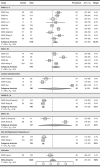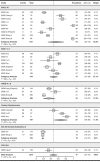The prevalence of depression, anxiety, and sleep disturbances in COVID-19 patients: a meta-analysis
- PMID: 33009668
- PMCID: PMC7675607
- DOI: 10.1111/nyas.14506
The prevalence of depression, anxiety, and sleep disturbances in COVID-19 patients: a meta-analysis
Abstract
Evidence from previous coronavirus outbreaks has shown that infected patients are at risk for developing psychiatric and mental health disorders, such as depression, anxiety, and sleep disturbances. To construct a comprehensive picture of the mental health status in COVID-19 patients, we conducted a systematic review and random-effects meta-analysis to assess the prevalence of depression, anxiety, and sleep disturbances in this population. We searched MEDLINE, EMBASE, PubMed, Web of Science, CINAHL, Wanfang Data, Wangfang Med Online, CNKI, and CQVIP for relevant articles, and we included 31 studies (n = 5153) in our analyses. We found that the pooled prevalence of depression was 45% (95% CI: 37-54%, I2 = 96%), the pooled prevalence of anxiety was 47% (95% CI: 37-57%, I2 = 97%), and the pooled prevalence of sleeping disturbances was 34% (95% CI: 19-50%, I2 = 98%). We did not find any significant differences in the prevalence estimates between different genders; however, the depression and anxiety prevalence estimates varied based on different screening tools. More observational studies assessing the mental wellness of COVID-19 outpatients and COVID-19 patients from countries other than China are needed to further examine the psychological implications of COVID-19 infections.
Keywords: anxiety; coronavirus; depression; meta-analysis; pandemic; sleep disturbance.
© 2020 New York Academy of Sciences.
Conflict of interest statement
The authors declare no competing interests.
Figures





References
Publication types
MeSH terms
LinkOut - more resources
Full Text Sources
Other Literature Sources
Medical

